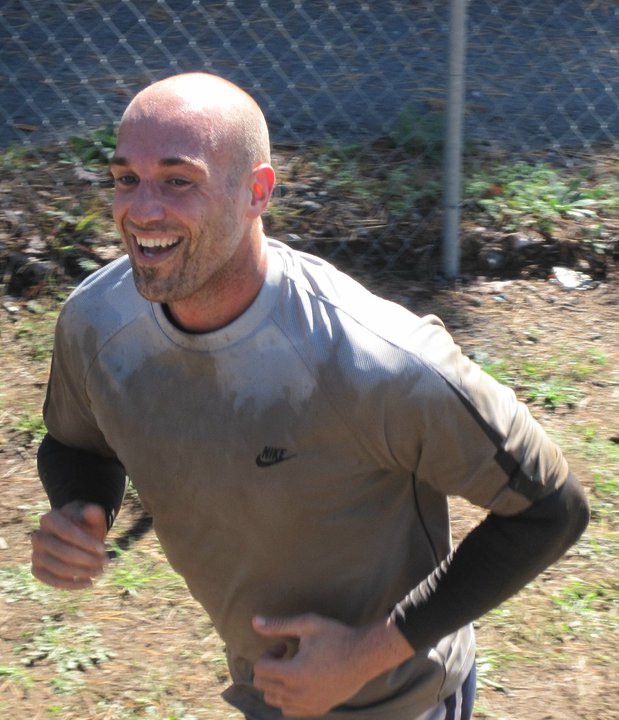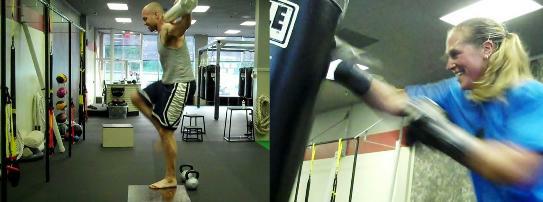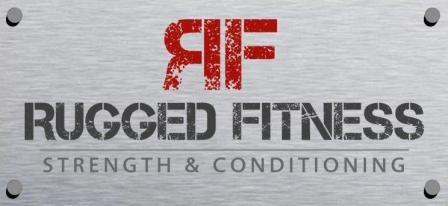Live Rugged!!!
Are You Making The Right Changes??
by Rugged Coaches on 05/06/15
Contributed by Coach Brian
Your Own Worst Enemy?
Reaching your goals can sometimes feel like an uphill battle that just keeps getting harder as you go. Why is it that some people, with seemingly similar time and resource constraints, can still achieve success in areas that you fall short? Why were you able to be successful in the past but can’t seem to get back on the right track after falling off? What’s really holding you back? To answer those questions, you must first reflect on your current situation and answer the more important question: How much of that steep incline that you're fighting against is actual real world obstacles, and how much is mental or emotional baggage manufactured in our own head?
In all aspects of our lives we have to overcome obstacles to achieve what we want. In order to do this we draw on a combination of intrinsic and extrinsic motivational factors to help us do what needs to be done to achieve the desired results. Much like standing at the center of a seesaw and trying to get to one side, if there is a ton of weight piled up on the side you don’t want to be on, then it’s going to be a steep climb to get to the other end. That means you have one of two options, try to pile up more weight on the positive side, or try to remove some of the weight from the negative side.
Tipping The Scales In Your Favor
Most people immediately start trying to pile a bunch of
positive behaviors on the good side of the seesaw, which is not all together a bad thing. Making steady, progressive positive change is essential. However, many people fail to look at the
behaviors that they are still doing on a regular basis that are dragging them
back down. They say old habits die hard
because it’s always tougher to give up something you are used to than to jump into some
new thing that you think might help.
That’s why you see people doing things like taking weight loss
supplements, but still eating junk food multiple times a week. Or my personal favorite, hardcore diet and
exercise during the week and then completely blowing it up with food and drinks
all weekend. If you’re just looking for
a good way to maintain then that will be fine, but if you want to make progress
you have to start giving up some of your bad habits.
Before you start trying to find the next big miracle product that will change your life, start by actually changing your life. Also recognize that constructively addressing your detrimental exercise or nutrition behaviors is different than mentally beating yourself up over them. Nothing positive can ever come from negative self-talk so don't go down that road. Just take an objective look at which behaviors are the most counterproductive and then make small changes to them each week. If you hit some set backs, don't dwell on them and have a pity party. Just let them go and get back on track.
Our coaches are here to help you with making changes both in and out of the gym, so don't hesitate to contact us for a Strategy Session.
Are You Gettin' Enough Protein Bro?
by Rugged Coaches on 04/03/15
Contributed by Coach Adel
Much like determining appropriate use of the term “bro”, the amount of protein someone should consumes during the course of a day is an extremely debated and studied topic. For the sake of this discussion, I want to discuss the recommended amount of protein consumption based on an individual’s sex, age, activity level and desired weight outcomes. I will give a quick overview based on the current research and recommendation on protein use based on scientific research. In addition to these recommendations I will give my personal take on the role of protein supplements or other powdered “Meal” shakes can play in your diet. In the course of my education and experience selling supplements I have had the amazing opportunity to get paid to study, learn and experiment with various supplements. A lot of this time was spent researching the benefits, side effects, of various types and most importantly the taste of various sources of protein. With new changes to your diet or activity its best to consult your physician before starting any new supplements or training.
Current Guidelines
The joint position of the American College of Sports Medicine (ACSM) and Academy of Dietetics and Nutrition when it comes to the distribution of daily caloric intake:
•Carbohydrate 50-60% * 6-10 g/kg/bw/day
•Fat <30% total kcal/day * Less than 10% from saturated fat
•Protein – 15-20%
?1.2 – 1.4 g/kg/bw/day for male or female endurance athletes
?1.6 – 1.7 g/kg/bw/day for male or female strength athletes
?RDA 0.8 - 1.0 g/kg/bw/day
Bro, what does that mean? Simply put these recommendations give you a formula to determine a range of protein that would be acceptable for you.
Example A: An 80kg (80kg x2.2lbs= 176lbs) bro/lady who primarily runs is recommended to consume between 96 grams of protein to 112grams.
Example B: An 80kg bro/lady who primarily trains with weights and does some kettlebells, is recommended to consume between 128grams to 136grams.
Example C: An 80kg bro/lady who primarily walks and is not overly active, allocation is based on the recommended daily allowance (RDA), say they should consume in the ball park of 64 to 80 grams of protein.
Note for those watching their calories, 1 gram of protein = 4 kcal.
Effectiveness of Protein Supplementation based on Scientific Research
The effectiveness of protein supplementation in helping improve muscular recovery post exercises is extremely well documented and studied. A quick search of the literatures provides some compelling reasons why one should consume a high protein shake or bar post exercises. One review by Cermak et al. looked 22 randomized control trails, which had a total of 680 subjects. Protein supplementation showed a positive effect increasing fat free mass (FFM ) and 1-RM leg press compared with a placebo after prolonged resistance-type exercise training in younger and older subjects. Another review sponsored by the Military Nutrition Division, US Army Research Institute of Environmental Medicine (USARIEM), found results supporting some of the desired benefits of protein use but also demonstrating the need for further research. “Overwhelmingly, studies have consistently demonstrated the acute benefits of protein supplementation on post-exercise muscle anabolism, which, in theory, may facilitate the recovery of muscle function and performance… not, resulted in measureable reductions in muscle damage and enhanced recovery of muscle function”. In English, we have a lot of evidence suggesting that protein helps, but sometimes we find out it doesn’t or it doesn’t do it as well as we had hoped or expected.
Pasiakos SM1, Lieberman HR, McLellan TM. Effects of protein supplements on muscle damage, soreness and recovery of muscle function and physical performance: a systematic review. Sports Med. 2014 May;44(5):655-70. doi: 10.1007/s40279-013-0137-7.
Cermak NM, Res PT, de Groot LC, Saris WH, van Loon LJ. Protein supplementation augments the adaptive response of skeletal muscle to resistance-type exercise training: a meta-analysis. Am J Clin Nutr. 2012;96:1454–64. doi: 10.3945/ajcn.112.037556.
This Bro's Opinion
In my personal experience and training history protein shakes and others supplements has been an effective tool for curbing cravings, adding protein to my diet on the go, and improving recovery. From a hunger sensation perspective drinking one 12-16 oz. protein shake has several benefits; it fills your stomach and takes advantage of the “volume effect”: simply put you consume a large amount of lower caloric foods that will hopefully keep you from munching on higher caloric options. Don’t believe me? No problem try drinking a 16 oz. protein shake when you feel the urge to snack on something, finish the whole shake and then reevaluate how “hungry” you still are.
If you are on the move and can’t sit down to eat, or don’t have the time to prepare a meal with adequate amounts of protein, a shake or bar is a great option. Portable, resalable and for the most part don’t require refrigeration. Typical shake has about 22-25 grams of protein per serving, that’s about one skinless chicken breast or an average sized can of tuna.
Though my opinion is shaped from anecdotal insight, as it is based on research I find that protein consumption with a short period of time post exercises helps recovery. Most of my clients and athletes agree and most carry a tub or pack of protein bars with them in their car.
Okay so what protein supplements do I recommend?
There is an abundance of protein bars, and powders to choose from. They come in every imaginable flavor and from various sources. Which one you consume is really up you and your dietary, ethical, religious choices and taste buds. Here is a quick synapse of my experiences with various types:
|
Protein Source |
Pros |
Cons |
|
Whey *isolate= more protein and less lactose per weight * concentrated= less protein, cheaper, and may have more lactose |
· Its relatively cheap (except the grass fed stuff, which is tastes better but also pricy) · Mixes well · Comes in hundreds of flavors or unflavored · Fast dissolving
|
· Could have some Lactose · Comes from animal products (milk) · Some allergic considerations
|
|
Casein |
· Its relatively cheap · Mixes well · Comes in many flavors or unflavored · Slow digesting
|
· Could have some Lactose · Comes from animal products (milk) · Some allergic considerations
|
|
Vegetable Sources Pea, Rice, Hemp, , and or mixes of various vegetables and grains |
· Typically have greater vitamin and mineral content then milk based products · Work with those who have religious or other dietary restrictions |
· Typically more expensive per serving then milk based proteins · Can have unpleasant after taste · Harder to mix · May not be a complete protein (has all amino acids) |
Tips when shopping:
· Look for the amino profile if you want to compare proteins, you don’t need to know each and everyone but look for higher amounts BCAA(Branch Chain Amino Acids): leucine, isoleucine and valine
· L-glutamine which is another amino acid believed to be especially helpful with recovery
· Watch out for fillers , artificial sweeteners and or other crap that manufactures sneak into their products
· Be careful of labels that can be misleading, pay attention to how many grams of protein come per serving: Example : 22 grams of protein per serving of 25 grams, or 26 grams of protein in 40 grams serving. A lot of manufactures will print highly misleading labels to confuse you.
Outcome Based Decision Making
by Rugged Coaches on 04/02/15
Contributed By: Coach Tommy
How do I achieve my goals? When I speak to trainers, clients, and anyone who gets stuck in a conversation with me, this question always comes up. We get started on general topics and then eventually it turns to, "well, what are you trying to accomplish?". This is when I turn back to science class and go off on a tangent about the scientific method and outcome based decision making.
Most people already know for the most part what to do to get them to where they want to be. The problem is they never even attempt it because it seems too daunting or they expect something that worked for someone else will have the same exact effect for them. They may start with the perfect plan and execute it flawlessly, but what they choose to measure their success with falls short. Without proper feedback, we rarely continue behaviors even if they are successful.
Here’s an example:
Subject X wants to lose weight and uses the scale as his/her only tool for feedback. After three weeks the scale is only down by 2lbs. Clothes feel different and he/she is stronger than before. But because the scale hasn't dropped, subject X feels unsuccessful.
Should they have waited three weeks to measure? Should their weight be the only metric to look at for feedback?
So Subject X starts on a journey of a new fitness routine and decides after two weeks that it is not working. Based off what the new plan promoted, X is not convinced that it is going to be successful and decides to quit. The plan prescribed a minimum of six weeks. It also came with a meal plan that was recommended to supplement the training protocol.
How did they know it wasn't working? Maybe it takes the full six weeks for the body to adjust to the stimulus and show gains.
Rather than look at it and try to adjust for the variables that might be holding X back, X chooses to stop altogether. Even if he/she continued for the next six weeks and saw little or no change, that still gives us information on what works and doesn't work. By quitting earlier, one cannot draw a conclusion as to the effectiveness of the program because it was not completed. Moreover, they lost valuable information about what works (or doesn't work) specifically for themselves.
This is a sad reality for a lot training programs. People base their critiques off poorly designed experiments that don't actually acquire enough information to make an educated guess about the efficacy of the program.
Here is where being scientific about your goals becomes crucial. Set up an experiment. State what you think should happen. Decide how you are going to measure it. Give it a timeline. Define the independent variables you will be looking at and what will be the controls.
Example:
I want to gain 5lbs of muscle in four weeks.
I will attempt this by training 4x a week(independent variable) and not changing my diet(control).
I will measure success by my weight every three days, girth measurements each week on Sunday and Bodyfat % every two weeks.
What this allows us to do is monitor what is happening with some idea of why. Most people jump into a healthy lifestyle by changing diet, exercise and lifestyle all at once. What they then find is they were successful, but they’re not sure why. Maybe they didn't have to go through all that trouble if they had just focused on one aspect which could have the greatest effect.
The other benefit that comes from this approach is being able to make changes without starting all over. If after two weeks you find that there is no significant change in the direction you want; you adjust. If 4x a week isn't cutting it, try 5x and see what happens. The idea is to try something that will make you successful. Adding in large amounts of variables all at once leads to low adherence numbers.
Research has shown that when people try to change a single behavior at a time, the likelihood that they’ll retain that habit for a year or more is better than 80%. When they try two behaviors, their chances of success are less than 35%. When they try three behaviors or more, their success rate plummets to less than 5%(precision nutrition)
So set yourself up for success and follow a smart plan instead of a crazy all or none approach.
Here at Rugged fitness this is how we approach both our personal and group training. We test and measure the variables with our programming and client feedback.
Here are 5 easy steps
1. Decide on your objectives and what outcome you’re looking for. (For example, I wants to get leaner.)
2. Decide what evidence will show you what you want to know. (Change in my body composition.)
3. Gather the evidence. ( photos and skin fold measurements.)
4. Review and interpret the evidence. (I am is shrinking.)
5. Based on evidence, decide on next steps. (Keep doing what you’re doing. Yeah!)
How do you know you are wearing the right shoes?
by Rugged Coaches on 04/02/15
Contributed By: Coach Adel
We ask a lot from our feet: running, jumping, dancing, spinning and doing burpees. Shouldn’t we make sure our feet have what they need to do their job optimally? The type of shoes we wear should be determined by the activity we wish to engage in. It’s important to take into account your orthopedic history (any past injuries?), doctor prescribed inserts and your personal preference for shoe type (notice how I listed this last!). You may need to get custom made inserts, and that’s okay whatever keeps your feet and joints happy. Make sure to get them fitted to different shoes, so consult your podiatrist in case you use inserts or have a history of feet problems. Always check with your doctor before starting a new exercises or training program. We are now going to take a look at the three most common shoes we see someone wearing in our facility.
Cross training Shoes
Cross-training shoes or cross trainers is your “jack of all trades” shoes. They are the most frequent shoe we see and for good reason, they have enough flexibility in the material and arch support that they can be used for a variety of training classes and styles (Bootcamp, Running and Weightlifting). They combine a fraction of the cushioning from running shoes, the lateral ankle mobility from aerobic training shoes, and the flat heel of a weight lifting shoe. Those who participate in several types of classes or training modules would benefit from a cross trainer, instead of having a dedicated shoe for each training method. You can lift weights, run and or play sports in them.
Running Shoes
The running shoe made for running but can be worn to a group class in a pinch. Conventional wisdom has suggested the use of a running shoe with ample cushioning to absorb the shock on the pavement. There are those who are advocates for minimalist running shoes that have with almost no cushioning. No conclusive data exist to say which type of shoe is better, however the way you run or walk will vary dramatically depending on the shoe you wear. Conventional running shoes provided thick cushioning to the heel and mid foot, thus they can support a heel strike (heel makes contact with the ground first) running pattern. Minimalist shoes provided no cushioning and will result in pain and injury if you try and run with a heel strike pattern. Instead you must adopt a mid-foot to fore foot running pattern. This will allow the metatarsal area and your own arches to act as natural shock absorbers. If you don’t know what you’re running pattern is visit a local running shoe store that offers free video gait analyzes and running shoe fitting. If you are a frequent runner (3 or more times a week) , or run for extended periods of time its best to invest in dedicated pair running shoe. Running shoes can be worn to group training classes and be used for lifting weights; however they are not designed for this! They don’t provided the same lateral (side to side) stability as cross trainers, and the cushioned heel creates instability though your foot, and kinetic chain. Simply put running shoes are not the optimal option for group training, but they will do if you don’t wish to get a dedicated shoe.
Weight Lifting Shoes:
Weight Lifting shoes, like the name implies are dedicated to lifting weights. They provided a completely flat sole, plenty of friction (almost vacuum like to the floor) and a raised heel. You may ask why a raised heel? The raised heel creates additional mobility at the ankle joint, thus it dramatically improves your ability to squat or execute power lifts. Sounds crazy right! The next time you’re at the gym test this out by placing a 5 lb. plate underneath each heel, and then squat. You will notice how much easier it is to go deeper and maintain a more upright torso. Now weight lifting shoes are almost exclusively just good for lifting weights, kettlebells, or any activity with minimal running. Weight lifting might be for those who can’t attain the ankle mobility to properly perform squats, lunges or any type of loaded activity without significant compensation. The great thing about weight lifting shoes is that they last for almost ever; the shoe is typically made out of thick leather, and a wood or steal sole with rubber over it for stability.
Wear and Tear
How long can work out shoes last? Years? Wrong, workout shoes should be replaced frequently, how frequent will depend on the number of hours you work out, and the quality of shoe. A cheaper made show will break apart faster, the thread on the bottom will bald sooner; the arch and cushion will deform and deflate quicker. Typically the runners are advised to replace shoe wear every 300-500 miles, if you use cross trainers and don’t run as frequently look to change your shoes every 4-6 months, or based on the level of abuse you inflict on them.
Hope this helped you guys, feel free email me or any of the other coaches if you have any questions.
Adventure Races
by Rugged Coaches on 02/09/11
 Many people talk about wanting to lose weight and get in shape but struggle with finding the motivation to make it happen. Having something to prepare for, such as a wedding or a beach vacation, often helps people focus their energy and achieve the results that they desire. These events can allow individuals to find a level of discipline with their exercise and nutrition that they had previously been unable to attain. If you don’t have any upcoming events of personal importance, another way to harness that type of motivation is to find a challenge to commit yourself to.
Many people talk about wanting to lose weight and get in shape but struggle with finding the motivation to make it happen. Having something to prepare for, such as a wedding or a beach vacation, often helps people focus their energy and achieve the results that they desire. These events can allow individuals to find a level of discipline with their exercise and nutrition that they had previously been unable to attain. If you don’t have any upcoming events of personal importance, another way to harness that type of motivation is to find a challenge to commit yourself to.
Adventure races are a great way to help spur the motivation to get in the best shape of your life. By incorporating physical barriers into a running course, these races force you to train for strength and agility as well as the cardiovascular component that comes with running a normal race. This can help add a sense of excitement to your workouts knowing that you are training your body to overcome the real world obstacles that you will be encountering.
There are several upcoming adventure races in the northeast that you can sign up for including the 8 mile Tough Mudder in early May, the 3.2 mile Warrior Dash in August and the 3.2 mile Rugged Maniac in September. If this is your first time trying one of these races you may want to start with one of the shorter ones to see if you like it. I personally did the Rugged Maniac last year with some friends and we had a great time. Be sure to incorporate hill running into your training as I found that to be the toughest part of the course.




